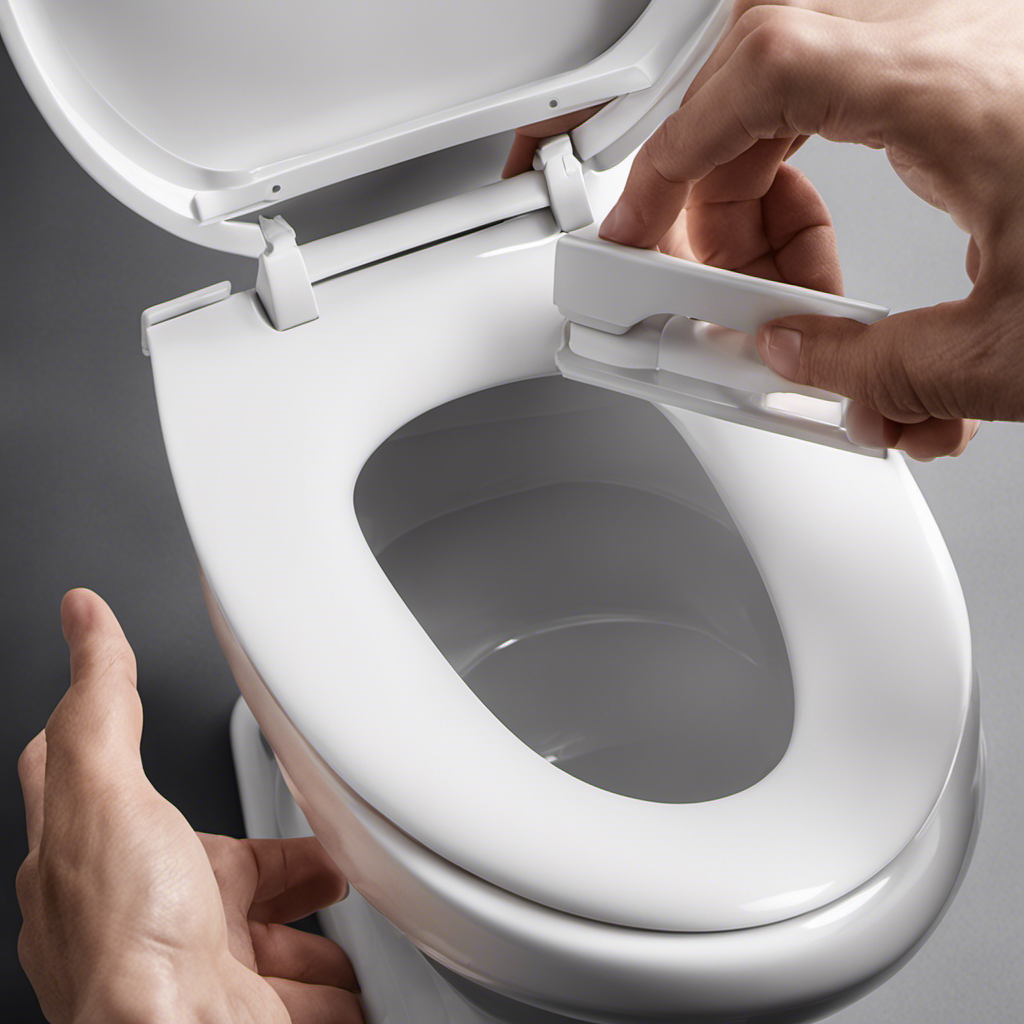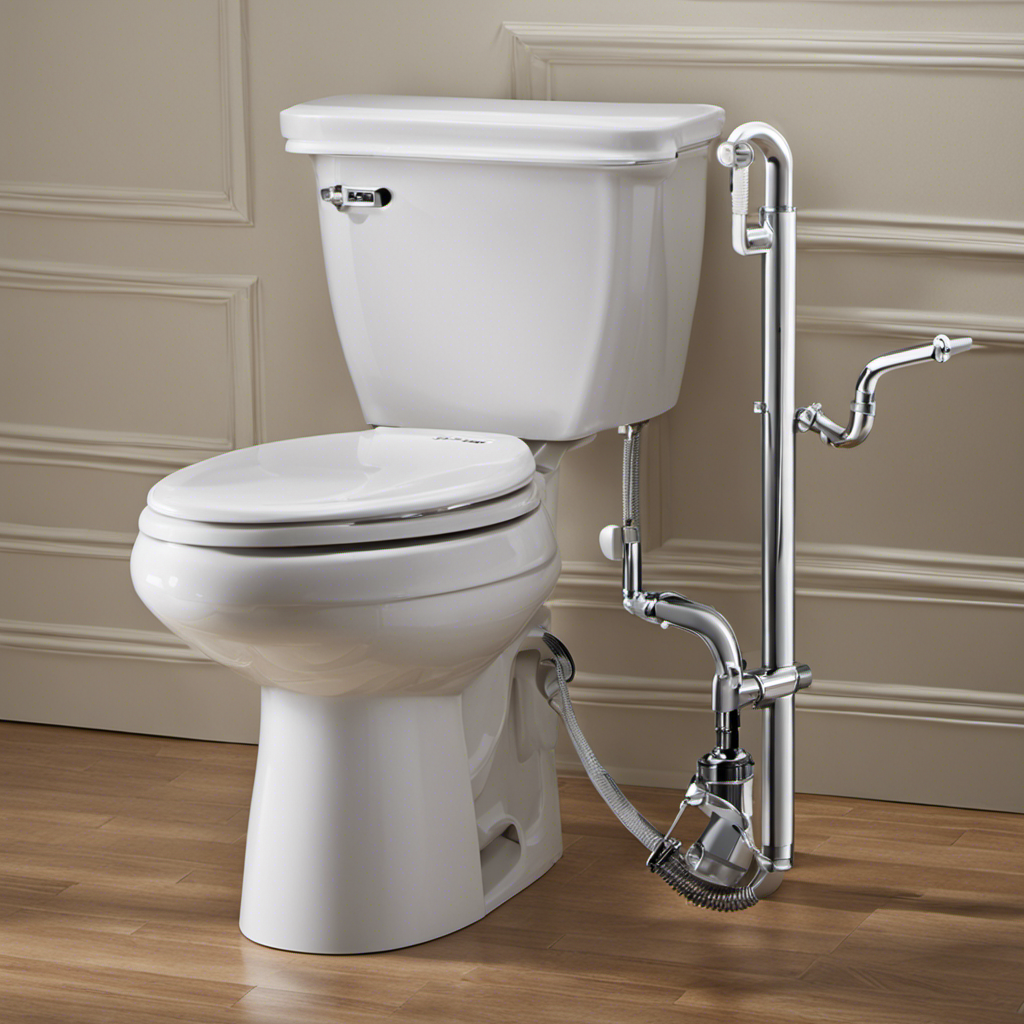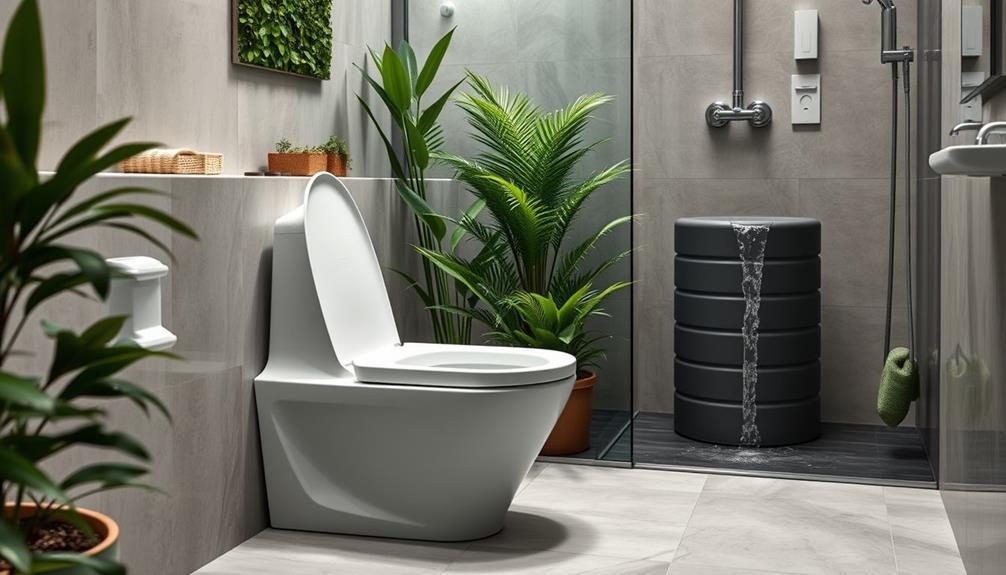Have you ever experienced the frustration of a toilet seat that won’t stay closed? It’s like trying to hold onto a slippery fish!
But fear not, because I’m here to guide you through the process of fixing your soft close toilet seat.
In this article, I will walk you through the steps of identifying the issue, checking the hinges, adjusting or replacing the damper, and maintaining the soft close mechanism.
So grab your tools and let’s get started on making your toilet seat close with a satisfying thud!
Key Takeaways
- Examine the hinges for damage or loose screws
- Adjust the damper to increase or decrease tension
- Replace the damper if necessary
- Regularly clean and lubricate the hinge area for maintenance.
Identifying the Issue
To identify the issue with your soft close toilet seat, you’ll need to first examine the hinges and check for any damage or loose screws. Troubleshooting common problems with a soft close toilet seat can be done by understanding the soft close mechanism.
This mechanism allows the seat to close slowly and quietly without slamming shut. If the seat is not closing properly or is slamming shut, it could indicate a problem with the hinges. Look for any visible damage or signs of wear on the hinges. Additionally, check if any screws are loose or missing. These issues can cause the soft close feature to malfunction.
By examining the hinges and checking for damage or loose screws, you can pinpoint the issue with your soft close toilet seat and proceed with the necessary repairs.
Now, let’s move on to checking the hinges to further troubleshoot the problem.
Checking the Hinges
Make sure you examine the hinges on the toilet seat to determine if they are loose or damaged. This step is crucial in fixing a soft close toilet seat.
Here are some tips to help you fix the issue:
-
Tighten the screws: Use a screwdriver to tighten any loose screws that connect the hinges to the seat. This can often solve the problem and restore the soft close feature.
-
Lubricate the hinges: Apply a lubricant, such as WD-40, to the hinges to reduce friction and ensure smooth movement. This can help the seat close softly and prevent any squeaking noises.
-
Check for damage: Inspect the hinges for any signs of damage, such as cracks or breaks. If you notice any damage, it may be necessary to replace the hinges.
-
Clean the hinges: Remove any dirt or debris from the hinges using a soft cloth or brush. This will help maintain the functionality of the hinges.
-
Test the seat: After tightening screws and lubricating hinges, test the seat to ensure that it closes softly and securely.
Adjusting the Damper
Adjusting the damper is an essential step in ensuring that the toilet seat closes gently and securely. When the damper is not adjusted properly, common problems such as the seat slamming shut or not staying up can occur.
To troubleshoot these issues, start by locating the damper. It is usually a small cylinder located on the hinge of the toilet seat. Use a screwdriver to turn the damper clockwise to increase the tension, or counterclockwise to decrease it.
Test the seat after each adjustment until you achieve the desired soft close effect. Remember to make small adjustments and test the seat each time to avoid over-tightening or loosening the damper.
Replacing the Damper
When replacing the damper, it’s important to choose a small cylinder that fits securely on the hinge of the toilet seat. This ensures proper functionality and prevents any issues with the soft close feature. To install the replacement damper, follow these steps:
- Remove the old damper by gently pulling it off the hinge.
- Clean the hinge area to remove any dirt or debris.
- Align the new damper with the hinge and press it firmly into place.
- Test the soft close function by gently closing the toilet seat. It should lower slowly and quietly.
- Troubleshooting issues: If the seat still slams shut or doesn’t close softly, check if the damper is properly aligned and securely attached.
Maintaining the Soft Close Mechanism
To keep the soft close mechanism working properly, it’s important to regularly clean and lubricate the hinge area. This will help prevent any issues and ensure smooth operation.
If you’re experiencing problems with your soft close toilet seat, there are a few common troubleshooting steps you can take.
First, check that the seat is properly aligned and securely attached to the toilet bowl. If it’s loose, tighten the screws or bolts as needed.
Next, inspect the hinge area for any debris or buildup. Use a mild soap and water solution to clean the hinges, making sure to remove any dirt or grime.
After cleaning, apply a silicone-based lubricant to the hinge area, following the manufacturer’s instructions. This will help maintain the smoothness of the soft close mechanism and prolong its lifespan.
Frequently Asked Questions
Can I Use Any Type of Damper to Replace the One on My Soft Close Toilet Seat?
Sure, you can use various types of dampers as alternatives for replacing the one on your soft close toilet seat. However, it’s important to consider compatibility and functionality to avoid common issues with soft close toilet seats.
Is It Possible to Fix a Soft Close Toilet Seat if the Hinges Are Loose or Broken?
Yes, it is possible to fix a soft close toilet seat if the hinges are loose or broken. To tighten the hinges, you can use a screwdriver to tighten the screws. If the hinge is broken, you may need to replace it.
How Long Does a Soft Close Toilet Seat Damper Typically Last Before It Needs to Be Replaced?
Soft close toilet seat dampers typically last for several years before needing replacement. However, if you’re experiencing issues, such as a loose or broken hinge, you may need to learn how to replace the damper or troubleshoot common problems.
Can I Adjust the Soft Close Mechanism to Make the Seat Close More Slowly or More Quickly?
Yes, you can adjust the soft close mechanism to make the seat close more slowly or more quickly. Troubleshooting a soft close toilet seat involves adjusting the hinges or the damper tension.
Is It Necessary to Disassemble the Entire Toilet Seat to Clean and Maintain the Soft Close Mechanism?
No, it’s not necessary to disassemble the entire toilet seat to clean and maintain the soft close mechanism. There’s a simple cleaning process that doesn’t require disassembly, making it easy and hassle-free.
Conclusion
Well, folks, we’ve reached the end of our journey to fix that pesky soft close toilet seat. I hope you’ve enjoyed our little adventure through the world of bathroom repairs.
Remember, identifying the issue is key, so don’t be afraid to get up close and personal with your toilet seat. Checking the hinges and adjusting the damper are simple yet effective solutions.
And if all else fails, don’t worry, you can always replace the damper. Just remember to maintain that soft close mechanism to avoid any future mishaps.
Happy fixing!










